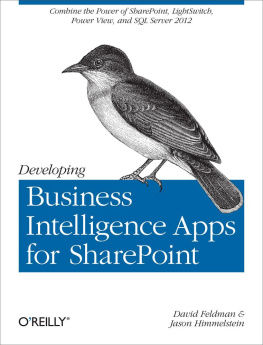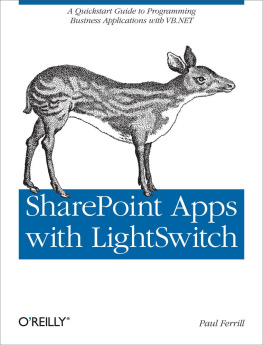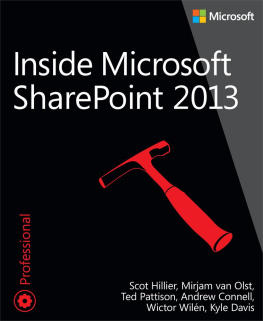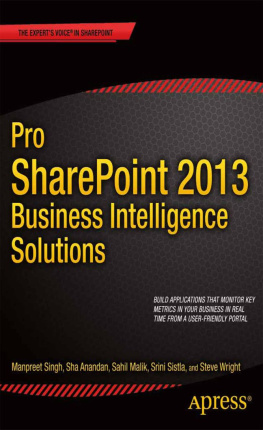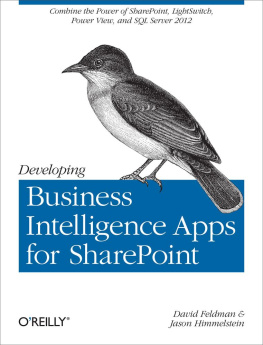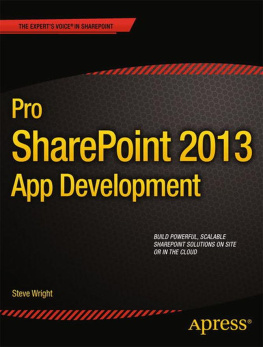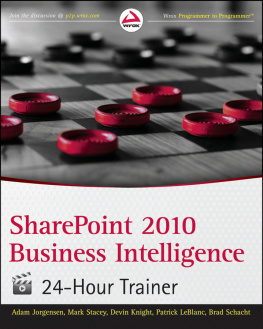Himmelstein Jason - Developing Business Intelligence Apps for SharePoint
Here you can read online Himmelstein Jason - Developing Business Intelligence Apps for SharePoint full text of the book (entire story) in english for free. Download pdf and epub, get meaning, cover and reviews about this ebook. City: Sebastopol;CA, year: 2013, publisher: OReilly Media, genre: Home and family. Description of the work, (preface) as well as reviews are available. Best literature library LitArk.com created for fans of good reading and offers a wide selection of genres:
Romance novel
Science fiction
Adventure
Detective
Science
History
Home and family
Prose
Art
Politics
Computer
Non-fiction
Religion
Business
Children
Humor
Choose a favorite category and find really read worthwhile books. Enjoy immersion in the world of imagination, feel the emotions of the characters or learn something new for yourself, make an fascinating discovery.
- Book:Developing Business Intelligence Apps for SharePoint
- Author:
- Publisher:OReilly Media
- Genre:
- Year:2013
- City:Sebastopol;CA
- Rating:3 / 5
- Favourites:Add to favourites
- Your mark:
- 60
- 1
- 2
- 3
- 4
- 5
Developing Business Intelligence Apps for SharePoint: summary, description and annotation
We offer to read an annotation, description, summary or preface (depends on what the author of the book "Developing Business Intelligence Apps for SharePoint" wrote himself). If you haven't found the necessary information about the book — write in the comments, we will try to find it.
Developing Business Intelligence Apps for SharePoint — read online for free the complete book (whole text) full work
Below is the text of the book, divided by pages. System saving the place of the last page read, allows you to conveniently read the book "Developing Business Intelligence Apps for SharePoint" online for free, without having to search again every time where you left off. Put a bookmark, and you can go to the page where you finished reading at any time.
Font size:
Interval:
Bookmark:

Beijing Cambridge Farnham Kln Sebastopol Tokyo
If you purchased this ebook directly from oreilly.com, you have the following benefits:
DRM-free ebooksuse your ebooks across devices without restrictions or limitations
Multiple formatsuse on your laptop, tablet, or phone
Lifetime access, with free updates
Dropbox syncingyour files, anywhere
If you purchased this ebook from another retailer, you can upgrade your ebook to take advantage of all these benefits for just $4.99. to access your ebook upgrade.
Please note that upgrade offers are not available from sample content.
This may seem like a strange way to start a tech bookbut you really, really need to read this book. Let us explain. Well start with a little bit about ourselves and why we needed this book.
Im Dave, the developer. Ive been obsessed with Microsoft Web Application technologies since I was 16 years old. It began with the beta of classic ASP and Access 2.0 to be exact. Since then, Ive wound my way through every version of SQL Server, Site Server, .NET, Silverlight, SharePoint, and just about anything else I found in my MSDN subscription. Ive worked for startups and Fortune 100 companies in a myriad of different industries, in roles that include developer, architect, and even manager of a 30-person development team. Even with all of this great experience, I still really needed a book like this. Unfortunately, it didnt exist yet.
Im Jason, the IT professional. Ive been working in technology since my teens as well, however I chose a different path from Dave. While he was busy learning languages and writing code I was off discovering the intricacies of interconnected systems. From my first jobs managing desktops, to my experiences as an Active Director and Exchange architect, to finally winding up as a SharePoint Practice Director and Chief Solutions Architect whose job it is to architect and design SharePoint environments that work and perform at scale, I too have been looking for a book like this.
Over the past 15 years, Daves job has gotten a lot easier. Development used to start from scratch with developers tasks to code all aspects of a monolithic application which was deployed to a single server environment. To enable a high degree of developer productivity, we, the IT professionals, have a larger number of platforms to build out and integrate. In the last section of this book, Jason will give you the tools you need in order to be successful with all these technologies.
This book is about application architecture as much as it is about any of the individual technologies described in it. Einstein once advised to simplify as much as humanly possible, but no more. Throughout this book, well attempt to keep it simple while giving you the techniques you need to build effective business solutions using SharePoint, LightSwitch, and SQL 2012.
Our industry is undergoing an incredible amount of change right now and for Microsoft developers, things may even seem a bit unstable. In the past couple of years, as developers, weve seen the evolution of ASP.NET AJAX and ASP.NET MVC, WCF, SharePoint, Silverlight, and the Windows Azure public cloud. The SQL Server data platform has been adding new capabilities faster than the developer community can absorb them, including SSRS Native, SSRS SharePoint Integrated, Unified Dimensional Model, PowerPivot, Power View, tabular cubes, Master Data Services, and Data Quality Services to name a few. In addition, we have the Office platform where a strategy around personal self-service business intelligence (BI) has driven data visualization capabilities into Excel and PowerPoint, enabling information workers to commoditize the work of business intelligence professionals. As SQL Server and Office added new capabilities to create content, SharePoint became a way to share and collaborate around our data. To add even more complexity, new tools made the development of SharePoint features possible under SharePoint 2010, giving developers a way to extend the capabilities of Microsofts collaboration platform with our own ASP.NET code.
As developers, we are accustomed to a wide variety of technologies in our toolbox. Microsoft has done a great job of making Visual Studio into the most productive environment for writing business applications and has even used developers as an extended sales force for their server products. However, in 2010, Microsoft realized that the strategy of running a limited version of the .NET runtime in a web browser plug-in called Silverlight wouldnt work with the explosion of Internet-connected devices and the unanticipated success of the iPhone. This is unfortunate because Silverlight development is pretty awesomerobust tools, a high degree of interactivity, great controls, and good security. However, the number of platforms from iOS to Android to Windows Phone, WebOS, even cars, refrigerators, game consoles, TVs, and anything else with a few circuit cards in it is far too vast. Microsoft realized at the peak of Silverlights popularity in 2010 that they needed to start over and begin to focus on open standards like HTML and JavaScript if they wanted to reach every connected device. The big downside, of course, is that HTML and JavaScript are far more limited than compiled .NET code. The challenge of creating complex applications that function well on many devices is not unique to Microsoft; industry-wide, this evolution will continue to unfold for the next few years. As a result, product life cycles are being compressed; instead of two to three years, new capabilities appear multiple times per year, making it nearly impossible to keep up.
As a designer of business solutions, we are given the financial and human capital of our customers and are trusted to devise solutions that are maintainable and that will evolve to meet future needs. Imagine a world where you spend less time thinking about plumbing code and more time solving real problems. A world where model-driven applications and reporting evolve and grow over time instead of becoming brittle and filled with bugs from past developers. If that sounds pretty good to you, then you should really read this book.
If youre reading this, youre probably involved in the creation of business applications or business intelligence solutions, or maybe you arent yet and would like to be. We build these apps to solve a problem or fulfill a need that our customers have and as such, we want to create a solution quickly. We want to write as little code as possible while still creating a really great solution that is maintainable. Using SharePoint, LightSwitch, and SQL 2012, we can create powerful solutions in record time. Lets explore the parts.
SharePoint Server is Microsofts web portal, collaboration, social, and business intelligence platform. Basically, think of it as the center of the world for business collaboration. The scenario in this book works on SharePoint 2010, but we will also discuss SharePoint 2013, including changes to the app model in the next release to make sure that our solution grows and evolves over time.
Visual Studio LightSwitchVisual Studio LightSwitch is a model-driven development capability that provides the easiest way to build data-driven applications for the Web and desktop that are deployable on-premise or to the cloud. LightSwitch enables us to focus on business logic by freeing us from the plumbing code and many of the technology decisions. We discuss in detail the evolution of the LightSwitch productfrom LightSwitch 2011 to LightSwitch within Visual Studio 2012 and the HTML client released in Visual Studio 2012 Update 2and how we can use this platform to protect our investment and deliver value faster to our customers.
Font size:
Interval:
Bookmark:
Similar books «Developing Business Intelligence Apps for SharePoint»
Look at similar books to Developing Business Intelligence Apps for SharePoint. We have selected literature similar in name and meaning in the hope of providing readers with more options to find new, interesting, not yet read works.
Discussion, reviews of the book Developing Business Intelligence Apps for SharePoint and just readers' own opinions. Leave your comments, write what you think about the work, its meaning or the main characters. Specify what exactly you liked and what you didn't like, and why you think so.

